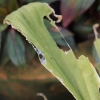How to recognise it
The field slug is the most common and most damaging species. It is usually grey to fawn in colour and 3 to 4cm in length. The garden slug is up to 4cm in length and dark grey to black. The black slug is the longest species, up to 15cm in length and black or orange-brown in colour. Finally, the keeled slug is grey, dark brown or black and up to 10cm long with a distinct ridge (the keel) running down the back of its body.
The silvery slime trails left behind as the slug moves along are usually the easiest identifier of slug damage. Since they feed at night you are less likely to spot the creatures themselves.
In moist, warm weather above ground damage is usually noticeable as irregular holes on leaves, stems, buds, flowers, seed-capsules and fruits of plants in the border, establishing lawns, lettuce, strawberries, peas, beans, celery, chicory, cabbages, cauliflowers and Brussels sprouts.
Below ground damage can appear as holes gouged out of tubers, corms, roots and bulbs.
You will occasionally find clusters of their round, white eggs in rotting vegetation/compost/soil.
Damage mainly occurs in the warmer spring and summer months, although the feeding season can be extended in glasshouses and frames.
Lifecycle
Slugs are hermaphrodite and mate at various times of year (this varies by species), each slug laying clusters of up to 50 round, white eggs in soil or rotting vegetation (including compost heaps) to protect the eggs during cold periods. The eggs usually hatch within one month of being laid, although some species lay in autumn, with the eggs remaining dormant until the spring.
The eggs hatch into small slugs which start eating foliage/stems from the day they are born. They are ready to mate when 1 year old.
Each slug lives for around 2 years and continues to feed through the year while the temperatures remain above freezing.
Why it’s a problem
Unlike snails, slugs do not have a shell and this means they can burrow into the soil, expanding their capability to do damage by giving them access to seedlings, roots, tubers and bulbs. Slugs feed using a file-like tongue called a radula which cuts into the plant tissue and scoops it out.
The ragged edges left on leaves which have been munched on can be susceptible to the grey mould fungus.
Where you are likely to find it
Generally found outdoors (although can sometimes be found in greenhouses) and best searched for at night. They can potentially attack any plant, although those with the most food (eg bulbs underground or lush leaves above ground) will usually be targeted first.
Plants commonly attacked include lettuce, brassicas, celery, potato tubers, strawberries, hostas, delphiniums, tulips, irises, annuals and alpines.
How to deter it
There are more thoughts on how to keep slugs off your prize plants than we can possibly encompass here. But here are a few you could try:
- ‘Traps’ of beer, using tubs (eg margarine tubs) sunk into the ground so the top is level with the soil. Then fill the traps with beer and/or honey and wait for the slugs to drop in. At least they’ll die happy!
- The skin of grapefruit halves left on the ground can also act as bait for the unsuspecting slug.
- Copper rings around the plant (settled slightly into the earth so there’s no ‘tunnel’ available under them) can prove effective, although expensive. They work on the principle of giving the slug a small electric shock as it tries to cross the copper. This is an Oakleaf Gardening favourite for lupin and delphinium protection! Copper tape for pots is also available.
- Various different surfaces around susceptible plants are claimed to deter slugs, such as gravel, gritty sand, broken up egg shells, hair, pine needles and soot.
Since slugs hide by day under garden rubbish, good general garden maintenance will help keep them exposed to predators. You can also look for eggs to squash in dark, moist places such as compost heaps.
Winter digging helps to expose and destroy overwintering eggs in the soil.
How to get rid of it
A nematode (Phasmarhabditis hermaphrodita) can be used to limit slug growth by infecting them with a fatal disease.
Chemical controls come in three forms; aluminium sulphate (which is an irritant), ferric phosphate and metaldehyde (which dehydrates the slug). These are usually sold as coloured pellets which are scattered over affected areas, but metaldehyde can also be purchased in liquid form. However, users should be aware that metaldehyde can be poisonous to more than just slugs and have been cited as a major contributor to the decline of the thrush in the UK. You could get around this problem by putting the pellets in a plastic milk carton laid on its side – the slugs will be able to get in but other animals will not. Aluminium sulphate and ferric phosphate are less toxic to birds and mammals.
Is it good for anything?!
Whilst the bane of gardeners’ lives, slugs do serve a useful purpose. They break down vegetation to help form rich organic matter in the soil that helps our plants grow better.
Other useful information
Slugs are closely related to other molluscs, such as the octopus and whelk.






